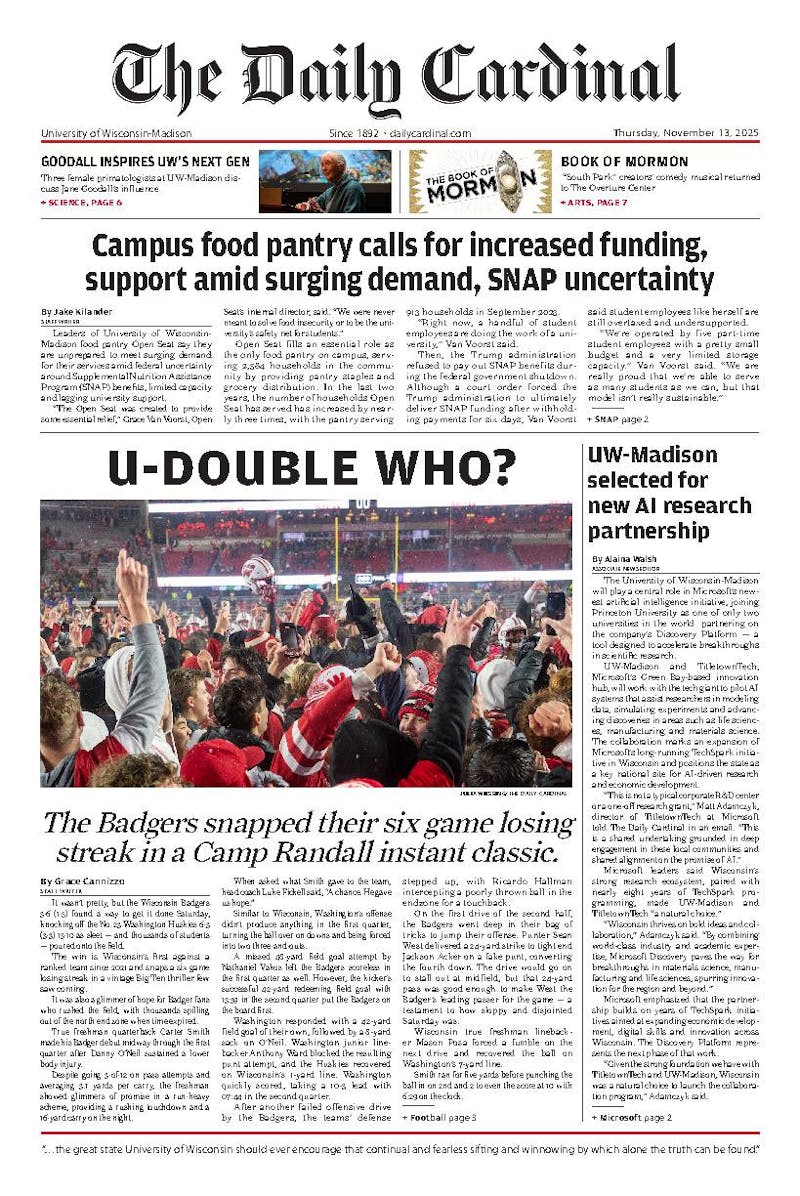Two days after my first real workout in a year and a half, I was in a bad way. I expected to be sore, but having my arms locked in a 45-degree permanent bear hug was more than I bargained for.
Before I ventured further into the world of weight lifting, it was clear that I needed some expert advice. I wanted to learn how to work out again, set up a good weight-training program, and, most importantly, not hurt so bad after leaving the gym.
I sought the guidance of Ron Carda, coordinator of UW-Madison's physical education activity program and a fitness expert with a Ph.D. in exercise physiology.
He said when someone first starts weight training, they should have two main goals: learn the proper lifting techniques and'this one is simple'just get to the gym with some consistency, eventually making it a habit.
According to Carda, 'once you get out there to four to six weeks and you look at the regularity that you've been lifting ... that's the time when you ask 'where do I want this program to take me''?
It's at that point when you pick a weight-training model. Your choices include the strength model, where you're going for pure size via heavy lifting and low repetitions, the endurance model, the 'tone-up, firm-up' plan involving lots of reps and lighter weights, or the power model, a hybrid of the strength and endurance schemes.
With your long-term goals in mind, it's time to focus on the workout itself. It was abundantly clear that I didn't know what I was doing when I went to the gym last week. Luckily, Carda cleared up a few misconceptions I had about weight training.
For the first part of the workout, it's important not to dive in headlong into the strenuous stuff. I usually stretch for a few minutes before I lift. According to Carda, this is not the best way to go.
'Recent research supports the fact that when you stretch a tissue, you actually weaken the tissue'that weakness may be maintained for 15 to 20 minutes,' Carda said. 'Why would you want to weaken your muscle before you ask it to perform'?
Carda suggested that a lot of folks confound the warm-up with stretching but these are 'two separate entities.'
Whether it's a few minutes of aerobic exercise on the bike or elliptical to get blood flowing to most of the muscle groups (a general warm-up) or some light lifts to warm-up to a heavy bench press, 'warm-ups are definitely beneficial,' Carda emphasized. 'If stretching is beneficial, it's best done after the work-out.'
Moving on to the actual weight lifting, it's no wonder I was so sore after my first workout'muscle growth is essentially repetitive tissue damage and repair.
Carda's analogy for muscle growth is intuitive: 'if I have a 10-ton bridge and drive a 20-ton truck over it, the bridge collapses. When we go back and rebuild the bridge, we're going to put a 20-ton bridge back in.'
Under the strength-training model, the lifter is going for growth in the cross-sectional area of the muscle, which is directly linked to muscle strength. In the endurance model, the muscles are being trained for stamina'muscle tissue adapts, attaining a greater blood flow to the active muscles, among other cellular changes, to avoid fatigue.
That soreness I felt after overexerting myself during the first workout is called 'delayed onset of muscle soreness,' or DOMS, and stretching, Carda said, wasn't going to repair the tissue damage that I intentionally caused.
A common myth is that soreness is caused by lactic acid build-up. But according to Carda, that 'lactic acid is metabolized,' or chemically broken down, 'within a matter of seconds.' Lactic acid is, however, behind the 'burn' that you feel in your muscles when you're doing heavy lifting, running hard or performing any other strenuous feats of strength.
Any time the body is damaged, either through weight lifting, accidental injury or during illness, the inflammatory response kicks in, when loads of fluids and the equivalent of cellular repairmen arrive at the site. It was all this activity that resulted in the sore, stiff state of my arms two days after my workout.
To avoid soreness, 'the progressions you make need to be incremental, very gradual,' Carda said. 'Even individuals who lift and are in very good shape, if they do different things or if they really make huge jumps, they'll feel it.'
However, this does not mean you have to focus on only a few muscle groups at a given visit to gym.
Commonly referred to as a 'split routine,' it gives the muscles time to recuperate after heavy lifting, but it's only necessary under the strength-training model. For the other two models, total body workouts can be performed.
But why turn your life into a real-life Gatorade commercial in the first place? We want results, and quick. It's possible that only after a few visits to the gym, you might see a 20-pound jump in your ability to lift.
Don't get too excited just yet.
'The majority of that increase in their ability to lift the weight is a neurological improvement, not a muscle improvement,' Carda stated. For example, 'when people first start dribbling a basketball, they use a lot of muscle to do it. ... Pretty soon they learn they only need to use the muscles in their finger tips.'
The lesson is that you need to give yourself time before you see results. As far as muscle growth is concerned, your genes dictate how fast or slow you'll be able to grow after pumping iron.
'The principle of individuality certainly exists,' Carda said. Fortunately, he assured that 'everybody is going to increase. ... That's why you need compare yourself with yourself.'
Finally, leave the tubs of GNC protein supplements at the door. According to Carda, the average weight lifter doesn't need it: 'It's expensive urine is basically what it comes down to.'





